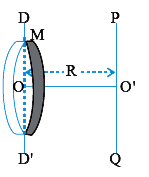why does a soild sphere have smaller moment od inertia than a hollow cylinder of same mass and radius , about an axis passing through their axes of symmetry ?
To understand why a solid sphere has a smaller moment of inertia than a hollow cylinder of the same mass and radius about an axis passing through their axes of symmetry, we need to analyze the distribution of mass in both objects.
1. Definition of Moment of Inertia:
- The moment of inertia (I) is a measure of an object's resistance to changes in its rotational motion. It depends on the mass distribution relative to the axis of rotation.
- The formula for moment of inertia is given by:
I=∫r2dm
where r is the distance from the axis of rotation to the mass element dm.
2. Moment of Inertia of a Hollow Cylinder:
- For a hollow cylinder, all the mass is concentrated at a distance equal to the radius (R) from the axis of symmetry.
- The moment of inertia for a hollow cylinder can be calculated as:
Ihollow=MR2
where M is the mass of the cylinder and R is its radius.
3. Moment of Inertia of a Solid Sphere:
- A solid sphere has mass distributed throughout its volume, not just at the surface.
- The moment of inertia for a solid sphere is calculated by integrating over its volume:
Isolid=25MR2
This formula shows that the mass is distributed at varying distances from the axis of rotation, with some mass elements being closer to the axis than the maximum radius R.
4. Comparison of Moments of Inertia:
- When we compare the two moments of inertia:
Ihollow=MR2andIsolid=25MR2
- It is evident that:
Isolid<Ihollow
This means the solid sphere has a smaller moment of inertia than the hollow cylinder.
5. Conclusion:
- The reason for this difference is due to the distribution of mass. In the hollow cylinder, all the mass is at a constant distance from the axis (the radius), while in the solid sphere, the mass is distributed throughout its volume, with many mass elements being closer to the axis of rotation. This results in a lower moment of inertia for the solid sphere.
- The moment of inertia (I) is a measure of an object's resistance to changes in its rotational motion. It depends on the mass distribution relative to the axis of rotation.
- The formula for moment of inertia is given by:
I=∫r2dm
where r is the distance from the axis of rotation to the mass element dm.
- For a hollow cylinder, all the mass is concentrated at a distance equal to the radius (R) from the axis of symmetry.
- The moment of inertia for a hollow cylinder can be calculated as:
Ihollow=MR2
where M is the mass of the cylinder and R is its radius.
- A solid sphere has mass distributed throughout its volume, not just at the surface.
- The moment of inertia for a solid sphere is calculated by integrating over its volume:
Isolid=25MR2
This formula shows that the mass is distributed at varying distances from the axis of rotation, with some mass elements being closer to the axis than the maximum radius R.
- When we compare the two moments of inertia:
Ihollow=MR2andIsolid=25MR2
- It is evident that:
Isolid<Ihollow
This means the solid sphere has a smaller moment of inertia than the hollow cylinder.
- The reason for this difference is due to the distribution of mass. In the hollow cylinder, all the mass is at a constant distance from the axis (the radius), while in the solid sphere, the mass is distributed throughout its volume, with many mass elements being closer to the axis of rotation. This results in a lower moment of inertia for the solid sphere.
Topper's Solved these Questions
- SYSTEM OF PARTICLES AND ROTATIONAL MOTION BOOK - NCERT EXEMPLAR ENGLISHCHAPTER - SYSTEM OF PARTICLES AND ROTATIONAL MOTION EXERCISE - Long answer type questions
12 Videos
- SYSTEM OF PARTICLES AND ROTATIONAL MOTION BOOK - NCERT EXEMPLAR ENGLISHCHAPTER - SYSTEM OF PARTICLES AND ROTATIONAL MOTION EXERCISE - Long answer type questions
12 Videos
- OSCILLATIONSBOOK - NCERT EXEMPLAR ENGLISHCHAPTER - OSCILLATIONSEXERCISE - All Questions
36 Videos
- THERMAL PROPERTIES OF MATTERBOOK - NCERT EXEMPLAR ENGLISHCHAPTER - THERMAL PROPERTIES OF MATTEREXERCISE - Very short Answer type Questions
15 Videos
Similar Questions
Why does a solid sphere have smaller moment of inertia than a hollow cylinder of same mass and radius, about an axis passing through their axes of symmentry ?
View SolutionThe moment of inertia of a cylinder of mass 1000gm and radius 20cm about the axis AB shown in figure is

View SolutionMoment of inertia of a ring of mass M and radius R about an axis passing through the centre and perpendicular to the plane is
View SolutionThe moment of inertia of a hollow cubical box of mass M and side a about an axis passing through the centres of two opposite faces is equal to.
View SolutionThe moment of inertia of a spherical shell and a hemispherical shell of same mass and radius about a tangential axis, passing through P will be

View SolutionCalculate the moment of inertia of a ring of mass 2kg and radius 2cm about an axis passing through its centre and perpendicular to its surface.
View SolutionCalculate the moment of inertia of a ring of mass 2kg and radius 2cm about an axis passing through its centre and perpendicular to its surface.
View SolutionThe moment of inertia of a cube of mass M and edge length a about an axis passing through one of its edge is
View SolutionFind the moment of inertia of a solid cylinder of mass M and radius R about a line parallel to the axis of the cylinder and on the surface of the cylinder.
View SolutionThe moment of inertia of a ring of mass M and radius R about PQ axis will be

View Solution
